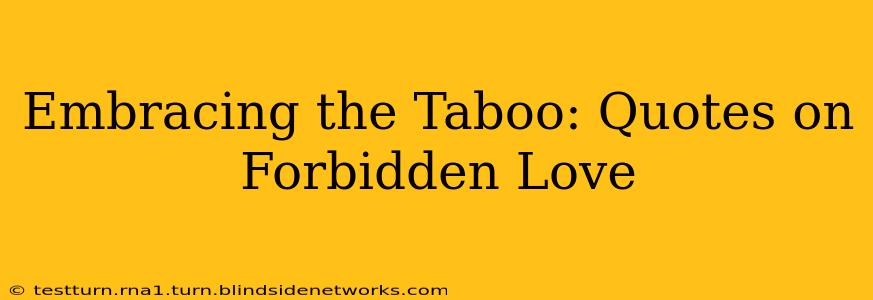Forbidden love. The very phrase whispers of danger, secrecy, and a passion that burns brighter because it's fueled by the impossible. It's a theme that has captivated storytellers and poets for centuries, weaving its way into our literature, our art, and even our own lives. We're drawn to it, perhaps because it reflects the inherent human desire to defy convention, to break free from the constraints of society, and to pursue love in all its forms, even the most treacherous. This exploration delves into the heart of this irresistible theme, exploring quotes that capture the essence of forbidden love's intoxicating allure and agonizing pain.
What Makes Forbidden Love So Compelling?
Forbidden love's allure lies in its very nature—the thrill of the chase, the risk, the secret shared glances across a crowded room, the hushed whispers in the dead of night. It's the allure of the unknown, the forbidden fruit that tastes so much sweeter because it's out of reach. But this intoxicating thrill is often intertwined with a deep, gnawing anxiety. The fear of discovery, the weight of societal disapproval, and the potential for heartbreak add layers of complexity that resonate deeply with readers and viewers.
"Where Love is a Sin, there is Always Joy in Secret." —From The Picture of Dorian Gray
This quote from Oscar Wilde encapsulates the intoxicating joy and simultaneous risk inherent in forbidden love. The "sin" represents the transgression against social norms, while the "joy in secret" highlights the thrilling intimacy found in clandestine relationships. The secrecy itself becomes an integral part of the experience, forging a bond strengthened by shared risk and the constant awareness of potential consequences.
What are the Common Challenges Faced in Forbidden Love?
Forbidden love often faces many obstacles. Social stigma, familial disapproval, and even legal restrictions can create a seemingly insurmountable wall between two people. The constant fear of exposure adds a significant layer of stress and anxiety to the relationship. This pressure can impact communication, trust, and ultimately, the very survival of the relationship. Navigating these obstacles requires courage, resilience, and a deep commitment to one another.
"Love looks not with the eyes, but with the mind, And therefore is winged Cupid painted blind." —William Shakespeare
Shakespeare's words highlight the irrationality of love, especially when it's forbidden. It's a love that transcends societal rules and logical reasoning. The blindness of Cupid suggests that forbidden love often ignores the practical consequences, prioritizing the emotional connection above all else. This makes the pursuit of forbidden love both beautiful and tragic.
How Can Forbidden Love Be Depicted in Literature and Art?
The depiction of forbidden love in literature and art is incredibly diverse. From tragic romances like Romeo and Juliet to more nuanced explorations of societal constraints in modern novels and films, the theme constantly evolves while retaining its core appeal. The contrast between the passionate intensity of the love and the harsh realities of its forbidden nature often creates dramatic tension that keeps audiences captivated. These narratives offer a reflection of societal norms and the ongoing struggle for individual expression and self-determination.
Does Forbidden Love Always End in Tragedy?
While many narratives depict forbidden love ending in tragedy, this isn't always the case. Some stories showcase couples overcoming the odds, defying societal expectations, and finding happiness together, though often at great personal cost. The ending depends on various factors, including the strength of the couple’s bond, their willingness to fight for their love, and the support (or lack thereof) from their community.
"The greatest love stories are those that are forbidden." —Anonymous
This quote speaks to the enduring appeal of forbidden love. The inherent drama and heightened stakes make these stories more memorable and resonant. The obstacles overcome and the sacrifices made solidify the relationship and leave a lasting impression on the audience. The perceived impossibility of the love only intensifies its emotional impact.
Conclusion: The Enduring Power of Forbidden Love
Forbidden love, with its blend of passion, risk, and transgression, continues to captivate us. It reflects our deepest desires, our longing for connection, and our inherent rebellion against societal constraints. Whether it ends in tragedy or triumph, the enduring power of forbidden love lies in its ability to mirror our own experiences with longing, desire, and the courage (or folly) of pursuing our hearts’ desires, even when those desires seem impossible.

